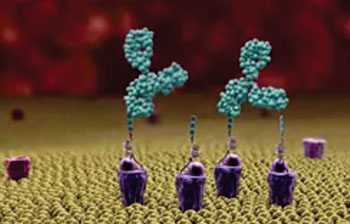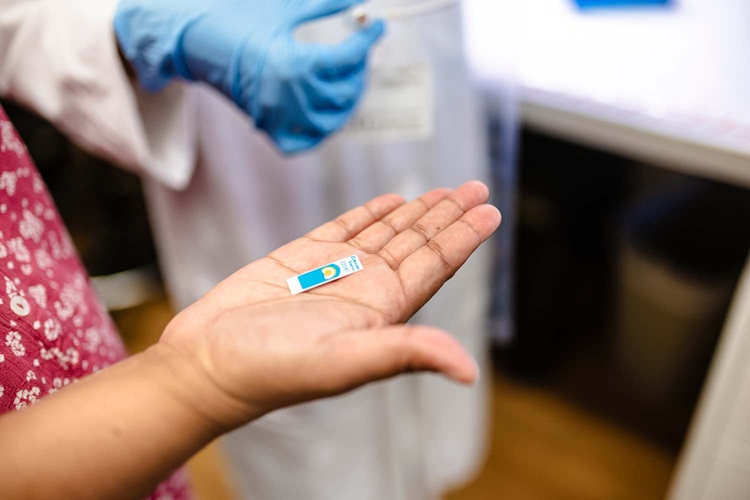DNA-Antibody Hybrid Molecule Shown to Be Effective Antibacterial Agent
|
By LabMedica International staff writers Posted on 18 May 2015 |

Image: Alphamers (purple) act as homing beacons, attracting pre-existing anti-alpha-Gal antibodies (green) to the bacterial surface (Photo courtesy of Altermune Technologies).

Image: Dr. Kary Mullis, founder of Altermune Technologies, received the Nobel Prize for chemistry in 1993 for his invention of the polymerase chain reaction (PCR) )Photo courtesy of Altermune Technologies).
A hybrid molecule comprising an aptamer attached to a trisaccharide terminating with alpha-gal (N-acetyl-glucosamine) was shown in a proof-of-principle study to be an effective antibacterial agent.
Aptamers are nucleic acid species that have been engineered through repeated rounds of in vitro selection to bind to various molecular targets such as small molecules, proteins, and nucleic acids. Aptamers are useful in biotechnological and therapeutic applications as they offer molecular recognition properties that rival that of antibodies. In addition to their discriminate recognition, aptamers offer advantages over antibodies, as they can be engineered completely in a test tube, are readily produced by chemical synthesis, possess desirable storage properties, and elicit little or no immunogenicity in therapeutic applications. Relative to monoclonal antibodies, aptamers are small, stable, and non-immunogenic.
Humans do not express the galactose-alpha-1,3-galactosyl-beta-1,4-N-acetyl-glucosamine (alpha-Gal) epitope. However, as a result of exposure to alpha-Gal in the environment, humans develop a large quantity of circulating antibodies that are specific for this trisaccharide.
Investigators at the University of California, San Diego (USA) developed a DNA aptamer that was able to bind to group A Streptococcus (GAS) bacteria by recognition of a conserved region of the surface-anchored M protein. To the 5′ end of this aptamer they conjugated an alpha-Gal epitope. This hybrid molecule was termed an "alphamer." The intent was that the aptamer segment of the alphamer would attach the molecule to the target bacterium while the alpha-Gal fragment would bind to the body's normally circulating anti-alpha-Gal antibodies.
In a paper published in the May 5, 2015, online edition of the Journal of Molecular Medicine the investigators showed that an anti-GAS alphamer could recruit anti-Gal antibodies to the streptococcal surface in an alpha-Gal-specific manner, elicit uptake and killing of the bacteria by human phagocytes, and slow growth of invasive GAS organisms in human whole blood.
These results constituted the first in vitro proof of concept that alphamers had the potential to redirect preexisting antibodies to bacteria in a specific manner and trigger an immediate antibacterial immune response.
"We are picturing a future in which doctors have a case full of pathogen-specific alphamers at their disposal," said senior author Dr. Victor Nizet, professor of pediatrics and pharmacy at the University of California, San Diego. "They see an infected patient, identify the causative bacteria, and pull out the appropriate alphamer to instantly enlist the support of the immune system in curing the infection."
The alphamer concept was attributed to contributing author Dr. Kary Mullis, winner of the 1993 Nobel Prize for chemistry for his invention of the polymerase chain reaction (PCR), technique. Dr. Mullis has established a biotech company, Altermune Technologies (Irvine, CA, USA), to develop alphamers into commercially viable therapeutic tools.
Related Links:
University of California, San Diego
Altermune Technologies
Aptamers are nucleic acid species that have been engineered through repeated rounds of in vitro selection to bind to various molecular targets such as small molecules, proteins, and nucleic acids. Aptamers are useful in biotechnological and therapeutic applications as they offer molecular recognition properties that rival that of antibodies. In addition to their discriminate recognition, aptamers offer advantages over antibodies, as they can be engineered completely in a test tube, are readily produced by chemical synthesis, possess desirable storage properties, and elicit little or no immunogenicity in therapeutic applications. Relative to monoclonal antibodies, aptamers are small, stable, and non-immunogenic.
Humans do not express the galactose-alpha-1,3-galactosyl-beta-1,4-N-acetyl-glucosamine (alpha-Gal) epitope. However, as a result of exposure to alpha-Gal in the environment, humans develop a large quantity of circulating antibodies that are specific for this trisaccharide.
Investigators at the University of California, San Diego (USA) developed a DNA aptamer that was able to bind to group A Streptococcus (GAS) bacteria by recognition of a conserved region of the surface-anchored M protein. To the 5′ end of this aptamer they conjugated an alpha-Gal epitope. This hybrid molecule was termed an "alphamer." The intent was that the aptamer segment of the alphamer would attach the molecule to the target bacterium while the alpha-Gal fragment would bind to the body's normally circulating anti-alpha-Gal antibodies.
In a paper published in the May 5, 2015, online edition of the Journal of Molecular Medicine the investigators showed that an anti-GAS alphamer could recruit anti-Gal antibodies to the streptococcal surface in an alpha-Gal-specific manner, elicit uptake and killing of the bacteria by human phagocytes, and slow growth of invasive GAS organisms in human whole blood.
These results constituted the first in vitro proof of concept that alphamers had the potential to redirect preexisting antibodies to bacteria in a specific manner and trigger an immediate antibacterial immune response.
"We are picturing a future in which doctors have a case full of pathogen-specific alphamers at their disposal," said senior author Dr. Victor Nizet, professor of pediatrics and pharmacy at the University of California, San Diego. "They see an infected patient, identify the causative bacteria, and pull out the appropriate alphamer to instantly enlist the support of the immune system in curing the infection."
The alphamer concept was attributed to contributing author Dr. Kary Mullis, winner of the 1993 Nobel Prize for chemistry for his invention of the polymerase chain reaction (PCR), technique. Dr. Mullis has established a biotech company, Altermune Technologies (Irvine, CA, USA), to develop alphamers into commercially viable therapeutic tools.
Related Links:
University of California, San Diego
Altermune Technologies
Latest BioResearch News
- Genome Analysis Predicts Likelihood of Neurodisability in Oxygen-Deprived Newborns
- Gene Panel Predicts Disease Progession for Patients with B-cell Lymphoma
- New Method Simplifies Preparation of Tumor Genomic DNA Libraries
- New Tool Developed for Diagnosis of Chronic HBV Infection
- Panel of Genetic Loci Accurately Predicts Risk of Developing Gout
- Disrupted TGFB Signaling Linked to Increased Cancer-Related Bacteria
- Gene Fusion Protein Proposed as Prostate Cancer Biomarker
- NIV Test to Diagnose and Monitor Vascular Complications in Diabetes
- Semen Exosome MicroRNA Proves Biomarker for Prostate Cancer
- Genetic Loci Link Plasma Lipid Levels to CVD Risk
- Newly Identified Gene Network Aids in Early Diagnosis of Autism Spectrum Disorder
- Link Confirmed between Living in Poverty and Developing Diseases
- Genomic Study Identifies Kidney Disease Loci in Type I Diabetes Patients
- Liquid Biopsy More Effective for Analyzing Tumor Drug Resistance Mutations
- New Liquid Biopsy Assay Reveals Host-Pathogen Interactions
- Method Developed for Enriching Trophoblast Population in Samples
Channels
Clinical Chemistry
view channel
POC Breath Diagnostic System to Detect Pneumonia-Causing Pathogens
Pseudomonas aeruginosa is a major cause of hospital-acquired and ventilator-associated pneumonia, particularly in lung transplant recipients and patients with structural lung disease. Its ability to form... Read more
Online Tool Detects Drug Exposure Directly from Patient Samples
Doctors often rely on patient interviews and medical records to determine what medications a person has taken, but this information is frequently incomplete. People may forget drugs they used, take over-the-counter... Read moreMolecular Diagnostics
view channel
STI Molecular Test Delivers Rapid POC Results for Treatment Guidance
An affordable, rapid molecular diagnostic for sexually transmitted infections (STIs) has the potential to be globally relevant, particularly in resource-limited settings where rapid, point-of-care results... Read more
Blood Biomarker Improves Early Brain Injury Prognosis After Cardiac Arrest
After a cardiac arrest, many patients remain unconscious for days, leaving doctors and families facing uncertainty about whether meaningful recovery is possible. Current tools to assess brain damage, including... Read more
Biomarkers Could Identify Patients at High Risk of Severe AKI After Major Surgery
Acute kidney injury is one of the most common and dangerous complications after major surgery, particularly among patients in intensive care. Even mild impairment of kidney function can lead to long-term... Read more
CLIA Test Identifies Head and Neck Cancer Recurrence from Post-Surgical Lymphatic Fluid
While the lymphatic system’s critical role in metastasis has long been recognized, routine access to patient lymph has been elusive. Now, a non-invasive process can access lymph through the collection... Read moreHematology
view channel
MRD Tests Could Predict Survival in Leukemia Patients
Acute myeloid leukemia is an aggressive blood cancer that disrupts normal blood cell production and often relapses even after intensive treatment. Clinicians currently lack early, reliable markers to predict... Read more
Platelet Activity Blood Test in Middle Age Could Identify Early Alzheimer’s Risk
Early detection of Alzheimer’s disease remains one of the biggest unmet needs in neurology, particularly because the biological changes underlying the disorder begin decades before memory symptoms appear.... Read more
Microvesicles Measurement Could Detect Vascular Injury in Sickle Cell Disease Patients
Assessing disease severity in sickle cell disease (SCD) remains challenging, especially when trying to predict hemolysis, vascular injury, and risk of complications such as vaso-occlusive crises.... Read more
ADLM’s New Coagulation Testing Guidance to Improve Care for Patients on Blood Thinners
Direct oral anticoagulants (DOACs) are one of the most common types of blood thinners. Patients take them to prevent a host of complications that could arise from blood clotting, including stroke, deep... Read moreImmunology
view channel
Blood Test Could Identify Colon Cancer Patients to Benefit from NSAIDs
Colon cancer remains a major cause of cancer-related illness, with many patients facing relapse even after surgery and chemotherapy. Up to 40% of people with stage III disease experience recurrence, highlighting... Read moreBlood Test Could Detect Adverse Immunotherapy Effects
Immune checkpoint inhibitors have transformed cancer treatment, but they can also trigger serious immune-related adverse events that damage healthy organs and may become life-threatening if not detected early.... Read moreMicrobiology
view channel
Breakthroughs in Microbial Analysis to Enhance Disease Prediction
Microorganisms shape human health, ecosystems, and the planet’s climate, yet identifying them and understanding how they are related remains a major scientific challenge. Even with modern DNA sequencing,... Read more
Blood-Based Diagnostic Method Could Identify Pediatric LRTIs
Lower-respiratory tract infections (LRTIs) are a leading cause of illness and death worldwide, and pneumonia is the leading infectious cause of death in children under five, claiming the lives of over... Read morePathology
view channel
Rapid Low-Cost Tests Can Prevent Child Deaths from Contaminated Medicinal Syrups
Medicinal syrups contaminated with toxic chemicals have caused the deaths of hundreds of children worldwide, exposing a critical gap in how these products are tested before reaching patients.... Read more
Tumor Signals in Saliva and Blood Enable Non-Invasive Monitoring of Head and Neck Cancer
Head and neck cancers are among the most aggressive malignancies worldwide, with nearly 900,000 new cases diagnosed each year. Monitoring these cancers for recurrence or relapse typically relies on tissue... Read more
Common Health Issues Can Influence New Blood Tests for Alzheimer’s Disease
Blood-based tests for Alzheimer’s disease are transforming diagnosis by offering a simpler alternative to spinal taps and brain imaging. However, many people evaluated at memory clinics also live with... Read more
Blood Test Formula Identifies Chronic Liver Disease Patients with Higher Cancer Risk
Chronic liver disease affects millions worldwide and can progress silently to hepatocellular carcinoma (HCC), one of the deadliest cancers globally. While surveillance guidelines exist for patients with... Read moreTechnology
view channel
Machine Learning Models Diagnose ALS Earlier Through Blood Biomarkers
Amyotrophic lateral sclerosis (ALS) is a rapidly progressive neurodegenerative disease that is notoriously difficult to diagnose in its early stages. Early symptoms often overlap with other neurological... Read more
Artificial Intelligence Model Could Accelerate Rare Disease Diagnosis
Identifying which genetic variants actually cause disease remains one of the biggest challenges in genomic medicine. Each person carries tens of thousands of DNA changes, yet only a few meaningfully alter... Read moreIndustry
view channel
BD and Penn Institute Collaborate to Advance Immunotherapy through Flow Cytometry
BD (Becton, Dickinson and Company, Franklin Lakes, NJ, USA) has entered into a strategic collaboration with the Institute for Immunology and Immune Health (I3H, Philadelphia, PA, USA) at the University... Read more









 assay.jpg)










